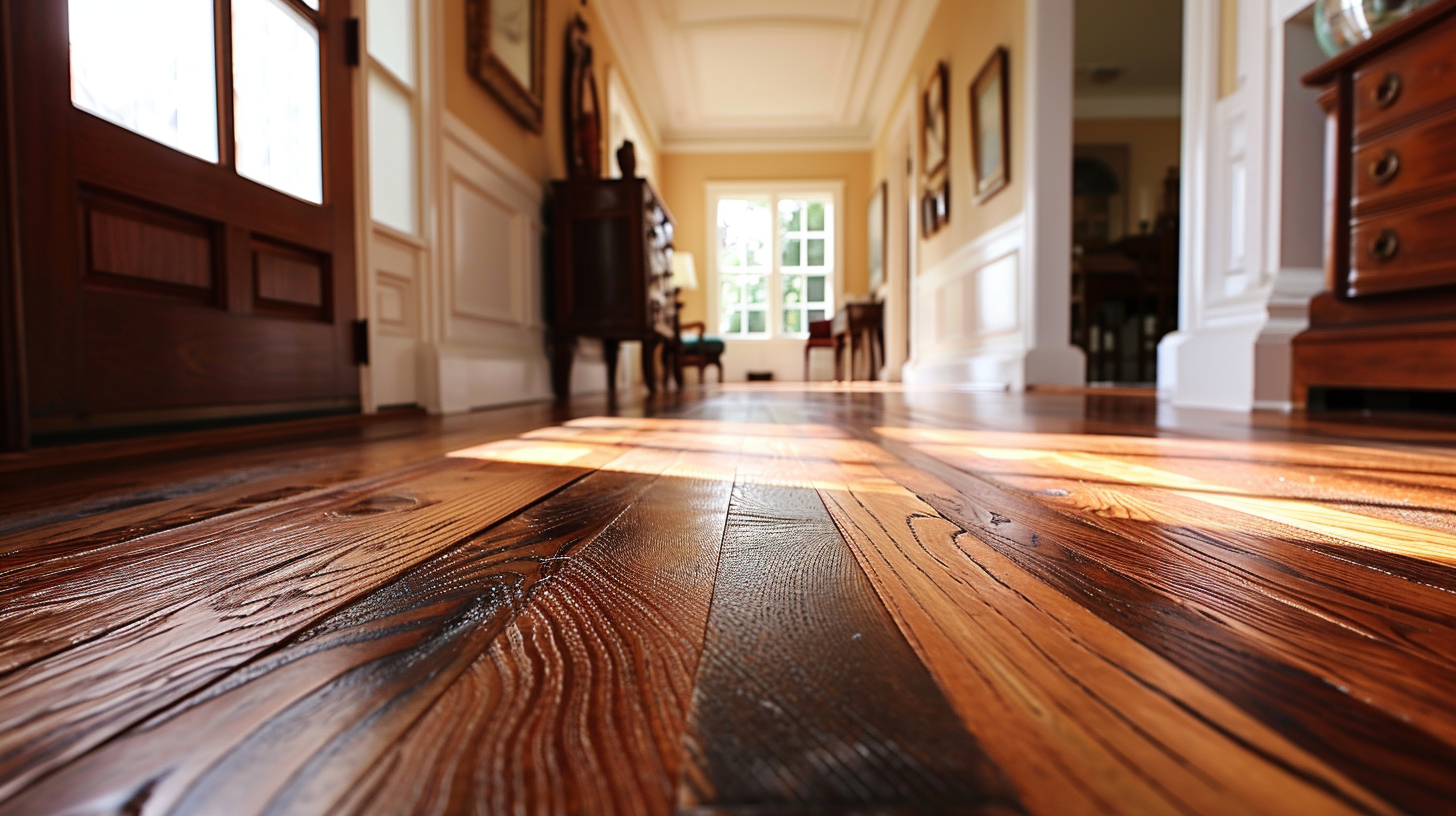Refinishing hardwood floors is a meticulous process that can restore the beauty and durability of your flooring. In this article, we will guide you through the steps involved in refinishing hardwood floors, from assessing their condition to applying multiple coats of finish for long-lasting results. With the right tools and materials, proper preparation, and careful application, you can achieve professional-level results and enjoy the beauty of your refinished hardwood floors for years to come.
Assessing the Condition of Your Hardwood Floors
To accurately assess the condition of your hardwood floors, it is crucial to carefully inspect each plank for any visible signs of wear or damage, such as scratches, dents, or discoloration. Evaluating the damage is essential in determining the appropriate refinishing method. Scratches and minor surface imperfections can often be addressed with a simple sanding and refinishing process. However, deeper gouges or extensive discoloration may require more extensive repairs, such as replacing damaged planks or applying a stain to even out the color. It is important to choose the right refinishing method based on the severity of the damage and the desired outcome. Consulting with a professional in the field can provide valuable insight and guidance in selecting the most suitable approach for restoring the beauty and functionality of your hardwood floors.
Gathering the Necessary Tools and Materials
When it comes to refinishing hardwood floors, gathering the necessary tools and materials is crucial. From sanders and brushes to stain and finish, having the right equipment and supplies is essential for a successful project. Proper equipment selection and efficient gathering of supplies will ensure that you are well-prepared to tackle the task at hand.
Essential Tools and Materials
Acquiring the appropriate quantity of essential tools and materials is crucial for executing a successful hardwood floor refinishing project. When it comes to refinishing hardwood floors, two important factors to consider are choosing the right sandpaper grit and understanding the different types of wood stains. Choosing the right sandpaper grit is essential to achieving the desired finish. Coarse grits, such as 36 or 40, are used for heavy sanding to remove old finishes and deep scratches. Medium grits, like 60 or 80, are used for further sanding and smoothing the surface. Fine grits, such as 100 or 120, are used for the final sanding before applying the stain. Understanding the different types of wood stains is also important. There are oil-based stains, water-based stains, and gel stains. Each type has its own advantages and disadvantages, so it’s important to choose the right stain based on the desired color and finish. Overall, having the appropriate tools and materials is crucial in ensuring a successful hardwood floor refinishing project.
Proper Equipment Selection
Selecting the appropriate equipment for the hardwood floor refinishing project requires careful consideration of the necessary tools and materials. Equipment maintenance and safety precautions are essential factors to keep in mind during this process. Proper equipment selection ensures that the job is done efficiently and effectively, while also minimizing the risk of accidents or damage. Regular equipment maintenance is crucial to ensure that the tools are in good working condition and perform optimally. This includes cleaning and lubricating the equipment, checking for any loose or damaged parts, and replacing worn-out components. Safety precautions should also be taken into account when selecting equipment. This includes using tools with appropriate safety features, wearing protective gear such as gloves and goggles, and following the manufacturer’s instructions for safe operation. By considering equipment maintenance and safety precautions, one can ensure a successful hardwood floor refinishing project.
Gathering Supplies Efficiently
Efficiency in gathering supplies is essential for a successful hardwood floor refinishing project, as it ensures that all necessary tools and materials are readily available for use. Efficient supply gathering involves employing time-saving techniques to streamline the process and maximize productivity. One effective technique is creating a detailed checklist of all required items before starting the project. This ensures that nothing is overlooked and prevents unnecessary trips to the store. Another time-saving approach is organizing the work area by grouping similar items together, such as sanding tools, staining materials, and finishing products. This minimizes the time spent searching for specific items during the refinishing process. Additionally, utilizing online resources and local suppliers can help expedite the supply gathering process. By implementing these efficient supply gathering techniques, hardwood floor refinishing projects can be completed smoothly and with minimal disruption.
Preparing the Room and Protecting Surrounding Areas
To ensure a smooth and efficient hardwood floor refinishing process, it is essential to carefully lay down protective tarps and plastic coverings to safeguard the furniture and fixtures in the room. These protective measures are crucial in preventing any damage or debris from falling onto the valuable items within the space. Prior to refinishing the hardwood floors, proper room preparation is necessary to ensure a clean and organized work environment. This includes removing all furniture, rugs, and other objects from the room, as well as thoroughly cleaning the floors to remove any dirt or dust. Additionally, it is important to inspect the room for any loose floorboards or protruding nails that may need to be fixed prior to refinishing. By taking these protective measures and properly preparing the room, you can ensure a successful and efficient hardwood floor refinishing process.
Sanding and Removing the Old Finish
To begin the process of refinishing hardwood floors, it is necessary to sand and remove the old finish. Sanding is essential for creating a smooth and even surface for the new finish. Professional sanding techniques, such as using a drum sander or a random orbital sander, can help achieve the desired results. Additionally, selecting the appropriate tools for removing the old finish, such as a paint scraper or a chemical stripper, is crucial for efficient and effective removal.
Sanding Techniques for Refinishing
During the process of refinishing hardwood floors, it is essential to carefully consider and implement proper sanding techniques for effectively removing the old finish. One critical aspect to address is dust containment. Dust from sanding can spread throughout the area, creating a mess and potentially causing health hazards. To minimize dust, it is recommended to use sanding equipment with built-in dust collection systems or attach a vacuum system to the sander. Additionally, employing proper sanding patterns is crucial for achieving a smooth and even result. Start with a coarse grit sandpaper to remove the old finish and gradually move to finer grits for a polished finish. It is important to sand in a consistent and overlapping pattern to avoid creating uneven spots. By employing these techniques, one can achieve a beautiful and flawless finish when refinishing hardwood floors.
Best Tools for Removal
Frequently, professionals in the field recommend utilizing a combination of a drum floor sander and a detail sander to efficiently remove the old finish when refinishing hardwood floors. These removal techniques ensure that the old finish is completely stripped away, allowing for a smooth and clean surface for the new finish to adhere to. The drum floor sander is ideal for larger areas, as it covers more ground and quickly removes the old finish. On the other hand, the detail sander is perfect for reaching tight corners and edges that the drum sander may not be able to reach. Safety precautions are important when using these tools, such as wearing protective goggles, gloves, and a mask to prevent inhalation of dust particles. Additionally, it is crucial to follow the manufacturer’s instructions and to take breaks when needed to prevent fatigue and potential accidents.
Staining or Applying a Finish to the Wood
Applying a high-quality stain or finish to the wood enhances its natural beauty and provides long-lasting protection. When refinishing hardwood floors, choosing the right finish is essential to achieve the desired look and durability. There are various types of finishes available, including oil-based, water-based, and polyurethane. Each has its own advantages and considerations. Oil-based finishes offer a traditional, warm look and are easy to touch up. However, they can take longer to dry and may emit strong odors during application. Water-based finishes, on the other hand, dry quickly and have lower VOC levels, making them a more eco-friendly option. Polyurethane finishes are known for their durability and resistance to scratches and stains. Ultimately, the choice of finish depends on personal preference and the specific needs of the project. It is important to carefully consider the characteristics of each type before making a decision.
Applying Multiple Coats of Finish for Durability
To ensure maximum durability, it is recommended to apply multiple coats of finish, as this will enhance the protective layer of the hardwood floors. Applying thin coats of finish allows for better penetration and adhesion to the wood surface. It is important to wait for each coat to dry completely before applying the next one. The drying time can vary depending on the type of finish used and the environmental conditions. Typically, water-based finishes dry faster than oil-based finishes. It is essential to follow the manufacturer’s instructions regarding drying times and recoating intervals. Rushing the process can result in a compromised finish that is prone to scratches and wear. By applying multiple thin coats and allowing sufficient drying time between each coat, you can ensure a strong and long-lasting finish for your hardwood floors.
Tips for Maintaining and Caring for Refinished Hardwood Floors
Regularly sweeping and mopping your refinished hardwood floors, along with placing protective pads on furniture legs, are two simple yet effective ways to maintain and care for them. However, when it comes to long term maintenance, there are a few other important factors to consider. One of the most common refinishing mistakes is using the wrong type of cleaning products. Harsh chemicals or abrasive cleaners can damage the finish and strip away its protective layer. Instead, opt for gentle, pH-neutral cleaners specifically designed for hardwood floors. Another important aspect of long term maintenance is avoiding excessive moisture. Water spills should be promptly wiped up to prevent warping or cupping of the wood. Additionally, it is recommended to use rugs or mats in high traffic areas to minimize wear and tear on the refinished hardwood floors. By following these tips, you can ensure the longevity and beauty of your refinished hardwood floors.




